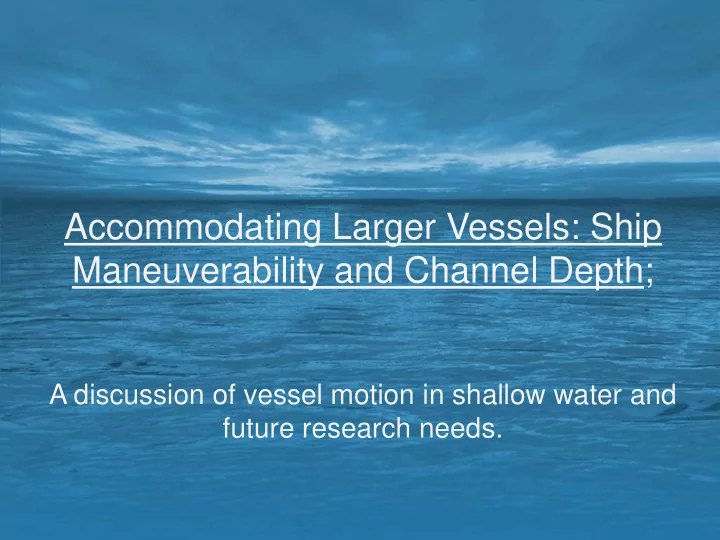

Accommodating Larger Vessels: Ship Maneuverability and Channel Depth; A discussion of vessel motion in shallow water and future research needs.
PANELISTS: Paul Amos: President, Columbia River Pilots. Larry Daggett: Vice President, Waterway Simulation Technology. Previously with Army Corps ERDC labs. Dan Jordan: Columbia River Bar Pilot, currently involved in a study of vessel dynamics on the Columbia River Bar. Mike Morris: Houston Ship Channel Pilot. Eric Burnette: Sr. Waterways Planner, Port of Portland, Oregon (moderator).
ORDER OF PRESENTATION: 1. Introduction of panelists. 2. Trends driving the discussion of vessel motion in shallow water. 1. Presentation on basic squat and under-keel definitions and concepts. 2. Very brief audience Q & A on key definitions and concepts. 1. Moderated discussion between panelists. 1. Audience Q & A.
An operational view of Vessel Motions Squat / Sinkage Heel / Roll Pitch / Wave Response
Real Scale in Calm Water
Components of Under Keel Clearance Survey allowance
Squat / Sinkage
Squat changes with speed and bottom contours
Roll / Heel
Increase of Draft due to List Beam 1º 2º 3º___ 60 ’ 0.52’ 1.05’ 1.57’ 80 ’ 0.70’ 1.40’ 2.09’ 100 ’ 0.87’ 1.75’ 2.62’ 110 ’ 0.96’ 1.92’ 2.88’ 120 ’ 1.05’ 2.09’ 3.14’ 140 ’ 1.22’ 2.44’ 3.66’ 160 ’ 1.40’ 2.79’ 4.19 ’’
Wave Response
Wave Response Offshore Swell height = 2m, period = 14 seconds 2.4m 1.2m EBB PostPanamax Handymax Swell (2.8m Hm0) Tidal Current (5.0kn) FLOOD 0.9m 2.8m Swell (1.7m Hm0) Tidal Current (3.0kn)
Effects of Squat on Vessel Maneuverability Directionally Stable with Pivot Point forward Directionally Unstable with Pivot Point aft
Effects of Squat on Vessel Maneuverability Normal Bow Pressure with Pivot Point forward Increased Bow Pressure with Pivot Point aft
Effects of Squat on Vessel Maneuverability Normal turning forces Increased bow pressure and shortened steering lever make turns difficult to control
MODELING OF SHIP SQUAT IN RESTRICTED CHANNELS Parameters used in Squat modeling and simulation predictions are as following: Fore Draft Yaw rate Aft Draft Type of bottom soil Channel Type: Unrestricted channel, Restricted channel Ship Breadth (with flooded banks), Canal (with surface piercing banks) Length Between Perpendiculars Depth of water (H average ) Length in Waterline Width of the channel (W) Block Coefficient Flooded bank height (h t ) Mid-Frame Coefficient Channel cross-sectional area from the longitudinal symmetry Volumetric Displacement plane of the ship to STBD (S STBD ) Number of Propellers Channel cross-sectional area from the longitudinal symmetry Bulb Type plane of the ship to PORT (S PORT ) Type of Stern Drift angle Transom stern width Metacentric height Gravity center Ship speed Waterway Simulation Technology
PANAMA CANAL SQUAT PREDICTIONS VS. SEA-TRIALS MEASUREMENTS Average bow or stern squat predictions to the measured DGPS values for ships Majestic Maersk Elbe Panamax containership Panamax tanker OOCL Fair Global Challenger containership Panamax bulk carrier Waterway Simulation Technology
PANAMA CANAL SQUAT PREDICTIONS VS. SEA-TRIALS MEASUREMENTS Waterway Simulation Technology
Effects of Current on Vessel Maneuverability A following current can increase the rate of turn
Effects of Current on Vessel Maneuverability An opposing current can decrease the rate of turn
Swept Path Examples 600’ x 106’ (Handy -max) with 1° leeway will have a 116.4’ actual beam width 800’ x 142’ (Afro -max) with 3° leeway will have a 183.7’ actual beam width 1100’ x 141’ (Container) with 4 ° leeway will have a 217.4’ actual beam width 1100’ x 141’ (Container) with 8 ° leeway will have a 292.7’ actual beam width Rule of Thumb
Safe Channel Width
Safer Ports don’t come about by accident
Vessel Motion Analysis
MODELING OF SQUAT IN RESTRICTED CHANNELS Salty Laker “John B.Arid” vs Fnh (Depth Froude Number) m/v Algoville vs. Fnh (Depth Froude Number) Waterway Simulation Technology
Low UKC Effects on Turning
Measured Squat Values & Prediction Equation - All Ship Types
Control with Tug Assistance
14 14 12 12 Speed 10 10 VESSEL SPEED (Knots) 8 8 BOW to BOW Transit Direction 6 6 SINKAGE (Ft) Southbound Containership, Nedlloyd Dejima LOA=942ft, Beam=106ft, Draft=39ft 4 4 2 2 0 0 Bow -2 -2 -4 -4 -6 -6 Stern -8 -8 3000 2000 1000 0 -1000 -2000 -3000 10 10 8 8 Southbound Containership, Nedlloyd Dejima BOW to BOW LAT. SPD. (FPS) ; ROLL (DEG) RATE of ROT. (DEG/MIN) LOA=941ft, Beam=106ft, Draft=39.0ft 6 6 Roll 4 4 YAW (DEG) 2 2 0 0 -2 -2 Rate of -4 -4 Rotation Yaw Lateral -6 -6 Speed -8 -8 -10 -10 3000 2000 1000 0 -1000 -2000 -3000 14 14 Bow Separation Distance (Ft) 12 12 Speed 10 10 Northbound Containership, Ever Refine VESSEL SPEED (Knots) 8 LOA=965ft, Beam=106ft, Draft=29.5ft 8 BOW to BOW Transit Direction SINKAGE (Ft) 6 6 4 4 2 2 0 0 Bow -2 -2 -4 -4 -6 -6 Stern -8 -8 -3000 -2000 -1000 0 1000 2000 3000 10 10 8 8 Northbound Containership, Ever Refine BOW to BOW LAT. SPD. (FPS) ; ROLL (DEG) LOA=965ft, Beam=106ft, Draft=29.5ft RATE of ROT. (DEG/MIN) 6 6 4 4 Roll YAW (DEG) 2 2 0 0 -2 -2 -4 -4 Yaw Lateral Rate of -6 -6 Speed Rotation -8 -8 -10 -10 -3000 -2000 -1000 0 1000 2000 3000 Bow Separation Distance (Ft)
What Else is on the Bottom?
How Important in Understanding Bank Suction?
VMAX UKC Upbound 9/16/2002 LOA=333.49m,B=70m,T=10.99m
Recommend
More recommend